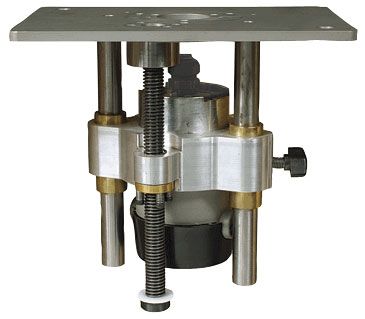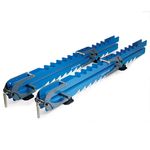Bench Dog - ProLift Router Lift PL1001
Bench Dog has upgraded its ProLift line, and now sells this router table accessory as model No. 40-016.
Bench Dog offers the ProLift in two versions. Model PL1002, made almost entirely from cast iron, is an industrial-weight product designed for continuous use in the shop. Model PL1001 is nearly identical, but most of the main components are made from aluminum, making the device more affordable for the occasional user. By the way, neither of the two ProLifts accepts a plunge router.
The ProLifts have lots of parts, but essentially they’re just fancy clamps that hold a router upside down. Each mounts to a plate that fits into a cutout in the top of the router table. To add a router to a ProLift, first remove the motor from its base. Then clamp the motor to the carriage of the lift. An adjustment system in each of the ProLifts lets you raise or lower the motor from above the router table. And, of course, when the motor goes up and down, so does the bit that you put in the collet.
The differences between the two ProLifts are related mostly to the router models they each can accept. The cast-iron ProLift (PL1002) accepts Porter-Cable’s model 7518, a big 3-1/4-hp fixed-base router. But with the addition of adapter rings, available as accessories from Bench Dog, the PL1002 also accepts several models of smaller (1-1/2 hp to 2 hp) fixed-base routers. They include Porter-Cable’s 690, Bosch’s 1617 and 1618, DeWalt’s 610 and Makita’s RF1100 and 1101.
The aluminum ProLift (PL1001) won’t accept the Porter-Cable 7518. But it does accept each of the smaller models listed above. The two Makita’s require an adapter ring to fit the aluminum ProLift. The other small routers don’t.
Both Bench Dog models use a pair of meaty 15/16-in.-dia. steel guideposts to support the carriage. And the carriage slides on hefty 3-in.-long bronze bushings. A 3/4-in.-dia. Acme-threaded drive screw is used to raise or lower the carriage, with the upper end of the screw running in a ball bearing. There is no backlash, or play, in the mechanism because the nut is spring-loaded.
Neither ProLift comes with a crank handle to raise or lower the carriage. Instead, all cranking is done with a ratchet wrench and 9/16-in. socket that you supply. At first, I suspected this was a subtle effort at cutting costs. But I soon realized the ratchet system worked especially well. Indeed, it was better than the crank systems on all of the other router lifts I looked at.
By using a tall socket with a 3-in. extension, it was easy to crank the router up or down while keeping my knuckles clear of the bit and fence. And a cleverly designed collar that slips over the socket allows you to read up-and-down movements of the bit in increments as small as 1/128 in.
With the insert rings removed, each ProLift has an opening in the plate large enough to allow the router collet to be raised above the table. That’s a big plus when changing bits because there’s no more need to hold the collet wrenches at awkward angles.
The cast-iron version of the ProLift comes with three chrome-plated steel insert rings with inside diameters of 2 in., 2-5/8 in. and 3-3/4 in. By adding an optional adapter to the 2-in. insert ring, it accepts the Porter-Cable guide bushings.
The aluminum ProLift comes with two insert rings, with inside diameters of 2 in. and 2-5/8 in. Adding an adapter to the smaller insert ring allows it to accept the Porter-Cable guide bushings.
Overall, I found both ProLift models easy and convenient to use. When it came to changing bits, these two got the highest marks in the class. And they scored well on adjustment, too. Indeed, I could raise or lower the bit as little as 0.001 in. without any fuss.
I also found both of them to be plenty sturdy. But there’s only one option—the Porter-Cable 7518—for those who want to use a large router. And the 7518 works only with the cast-iron ProLift.
If you plan to use one of the smaller routers, and use the router table every day, the cast-iron version would be the one to get. But for occasional users, the less-expensive aluminum model makes more sense to me.
Fine Woodworking Recommended Products

Blackwing Pencils

Rockler Deluxe Panel Clamp

Veritas Micro-Adjust Wheel Marking Gauge























Log in or create an account to post a comment.
Sign up Log in